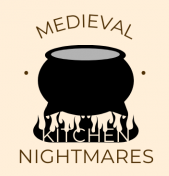Category: Experiential Archaeology Project
Our Conclusions and Reflections
We are very happy with how our experiential learning activity played out! Even if it was time consuming, it was a lot of fun to taste the different recipes, and we will definitely be remaking some dishes – like the Cinnamon Brewet and the Poudre Douce. That being said, there are always things that could have been done better when viewing our experience in hindsight. The main change would be our use of modern technology that likely affected the taste and texture profile of the food. We were very grateful for Nick’s food processor to grind the almonds and the breadcrumbs, but we missed out on the opportunity to really experience the demanding physical work of Medieval cooking. Our arms and hands were already aching after a couple of minutes, so we can’t imagine having to push through for 3 cups of almonds and 1 cup of breadcrumbs, on top of all the spices! We also used pre-ground cinnamon, nutmeg, and sandalwood, which might have affected the strength in flavours. Because of this, we also can’t testify to the true amount of time needed for the Apple muse and Almond milk – two dishes that would have spoiled very quickly. In addition, a hearth and stew pot would have enabled us to cook the stock and Cinnamon Brewet overnight (unsupervised), which would have augmented the flavour and tenderness of the meat.
Fowl roasting on a spit. A shallow basin collects the drippings to use in sauces or for basting; The Decameron, Flanders, 1432. CC Image source: Wikimedia. https://en.wikipedia.org/wiki/File:Decameron_1432-cooking_on_spit.jpg
Unlike modern cookbooks written for novices, Medieval cookbooks were generally written with the intended audience being an already experienced chef. As ⅔ of our group cannot be called experienced cooks by any stretch of the imagination, we struggled a bit with interpretation even before factoring some of the archaic language and phrasing used. With much of the recipe, especially for the Cinnamon Brewet, we were happy for Nick’s expertise in interpreting the instructions. This needed interpretation based on personal experience however, means that we may not have followed the instructions exactly as the original author intended.
We chose to make our own bread, something that would have been accurate for a large scale kitchen but maybe not for a more intimate personal kitchen. Most people were not equipped with the necessary equipment to grind flour, nor did everyone have an oven suited to baking bread. In the modern day it is much more expensive to buy rye ‘artisanal’ bread than it is to buy processed white bread, a complete flip of the reality in Medieval times (Kuropatnicki, 2009).
Image from Medievalists.net https://www.medievalists.net/2013/07/bread-in-the-middle-ages/
In conclusion, this experimental project showed us how easy we have it in our modern kitchens; with our powdered spices, pre-made broths and milks, and convenient ovens. The Medieval kitchen, while definitely functional and capable of producing good meals, required more time and work from the cooks. The question of availability also comes into play. For us, finding saffron, galangal, or cinnamon is a quick trip to the store in our car or an order on Amazon. In Medieval France, the more exotic spices were over sea and land, with individuals having to go to the market, walking or on horseback. A process that most likely took months, if not years, whereas now, something coming directly from Africa can do the distance in under forty-eight hours. For future projects, it would be interesting to try Medieval recipes from different regions (outside of Europe) and periods within the Middle Ages.
Thanks for joining us on our culinary journey to Medieval France!
Reference:
Kuropatnicki, A. K. (2009). English Nobleman’s Bread. Bread in Later Medieval and Tudor England. Studies in Foreign Language, 1, 49-73.
On Humours and Health
While recipes are now considered as mainly for making tasty dishes, in medieval times they also functioned as medicines to cause and maintain the good health of those ingesting them. The cooks of great lords would need to be especially vigilant, knowing the humours of all the different ingredients that passed through their kitchens and how they would react with eachother. Sauces and condiments made up of different spices were used to correct humoural imbalances in dishes and make the overall meal more easily digested (Taillevant & Scully, 1988). Unlike modern sauces, which are generally made of the same sort of ingredients as the dish they are going on (e.g. gravy on meat), medieval sauces were often meant to contrast in an effort to balance the humours of the dish.
Cooking methods were also used to compliment the humours of the cooked food, for example beef (a dry meat) was generally boiled, and pork (a wet meat) is generally roasted. Humoural theory is demonstrated in our cooking of the Cinnamon Brewet in which we stewed our beef and added ginger, one of the only spices considered “wet” (Taillevant & Scully, 1988).

Image from Classical Wisdom
https://classicalwisdom.com/science/medicine/the-humours-of-hippocrates-which-one-are-you/
Our recipes for barley water and almond milk come from a section in Le Menagier dedicated to “Beverages for the Sick”, demonstrating the role of recipes in medicine. There is also a section on “pottages for the sick”, pottage being an umbrella term for stew type dishes (Greco & Rose, 2009).
References
Greco, G. L., & Rose, C. M. (2009). The Good Wife’s Guide (Le Ménagier de Paris): A Medieval Household Book. Cornell University Press.
Taillevent, & Scully, T. (Ed). (1988). The Viandier of Taillevent: An Edition of all Extant Manuscripts. University of Ottawa Press.
Answering some of our Research Questions
If you remember from our proposal post, our first question for this experiential research was:
- What were the smells, taste, and texture of medieval French dishes, and how do they differ from modern-day Western recipes?
To set the scene, imagine a crowded kitchen (which wouldn’t have been relatable for royalty but maybe for peasants with big families) slowly warming up with multiple boiling pots. You hear the grinding of spices and almonds, the sizzling of meat, loud conversation, and some background music. You smell the Cinnamon Brewet — the mixture of beef, cinnamon, and wine. After 3 hours of cooking (from 11am to 2pm), you finally sit at a marble table with each dish served separately on nice plates. Dig in!
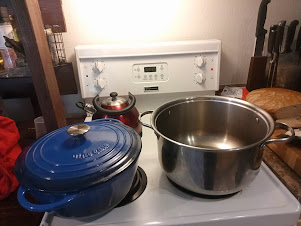
Our little set up!
Apple muse
| Flavor Nick = 6/10 Anjuli = 3/10 Audrey = 5/10 | Texture Nick = 1/10 Anjuli = 3/10 Audrey = 5/10 | Scent Nick = 7.5/10 Anjuli = 2/10 Audrey = 3/10 |
We all found that this dessert had a very strong taste of honey and licorice (we think this was due to the Rye bread). And the real kicker was that we couldn’t even taste the apples — we felt that all our hard work of peeling, cutting and boiling the apples had little reward! We didn’t see the point of eating it alone, and Nick thinks it would be better paired with some cheese. Also, the texture of the Apple muse was grainy with uneven clumps of bread — despite our efforts at grinding it by hand and by machine! Audrey didn’t dislike the texture all that much but would have preferred fewer bread crumbs to have more of a smooth puree. It smelled mostly of honey and wet bread — and we didn’t taste or smell the almond milk (not surprising after we tasted the milk by itself).
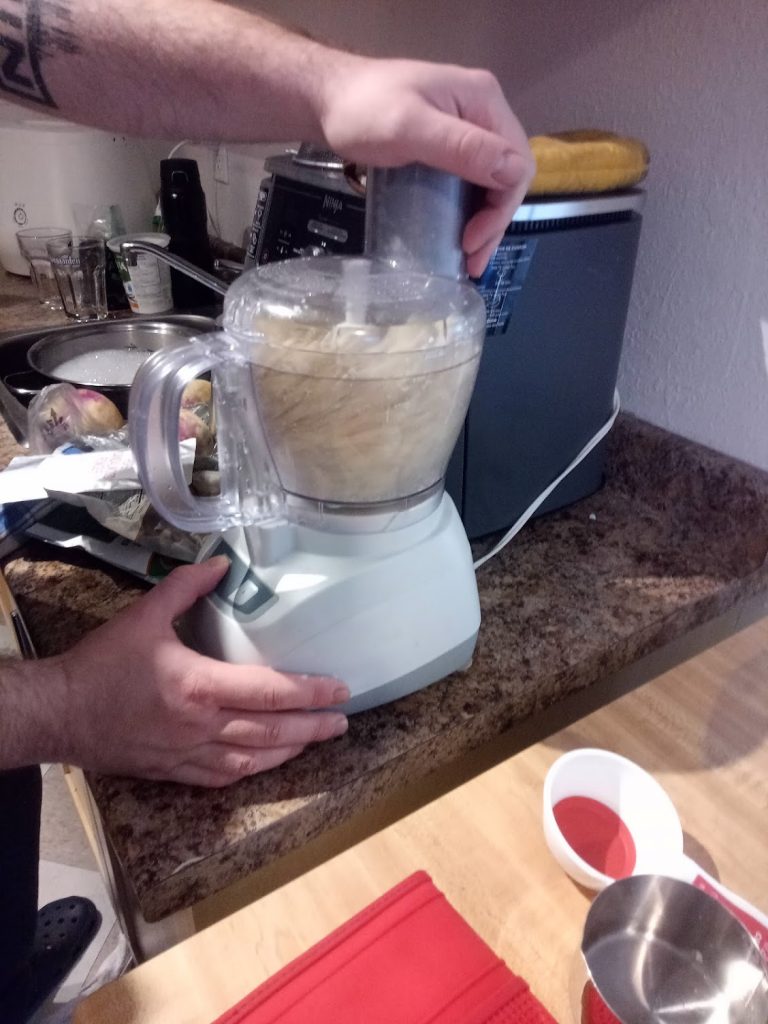
Thank God for the Industrial Revolution…
Turnips
| Flavor Nick = 6.5/10 Anjuli = 7/10 Audrey = 7/10 | Texture Nick = 8/10 Anjuli = 8/10 Audrey = 10/10 | Scent Nick = 8/10 Anjuli = 8/10 Audrey = 8/10 |
The turnips melted in our mouths after boiling them in beef stock and frying them in butter. Unfortunately, some of the pieces were very bitter and overpowered the taste of the butter and spices — this was likely a common occurrence for peasants without a garden. That being said, Anjuli discovered a new love for this vegetable and will try a second attempt at this recipe with a fresher selection of turnips.
Cinnamon Brewet
| Flavor Nick = 9/10 Anjuli = 7/10 Audrey = 9/10 | Texture Nick = 9/10 Anjuli = 8/10 Audrey = 9/10 | Scent Nick = 10/10 Anjuli = 10/10 Audrey = 10/10 |
The Cinnamon Brewet filled the kitchen with a wonderful mouth-watering scent of cinnamon… and the three-hour wait was so worthwhile! The meat was so soft and sweet (due to all the spices) and had a hint of wine. The almonds also added a nice crunch to every bite! That being said, we barely tasted the cinnamon — because of this, we believe that the recipe was modified to cater to modern cuisine since cinnamon is rarely used in our meals.
Almond Milk
| Flavor Nick = 2/10 Anjuli = 3/10 Audrey = 2/10 | Texture The milk as well strained and we didn’t have any stray almond in our cups | Scent The milk had no scent! |
The recipe that we used called the almond milk “quite a bit better than” the barley water (Greco & Rose, 2009), an observation that we wholeheartedly disagreed with. This was the most disappointing recipe!! It was so gross and lacked flavour — we could barely taste the almonds, and since there was no sweetener, it tasted like very, very, very diluted almond milk. The fact that the water (which can be argued not to have a taste) was the dominant flavour makes it so much worse! Audrey would describe it as dirty dishwater, and Nick also found that the almond milk coated his mouth.
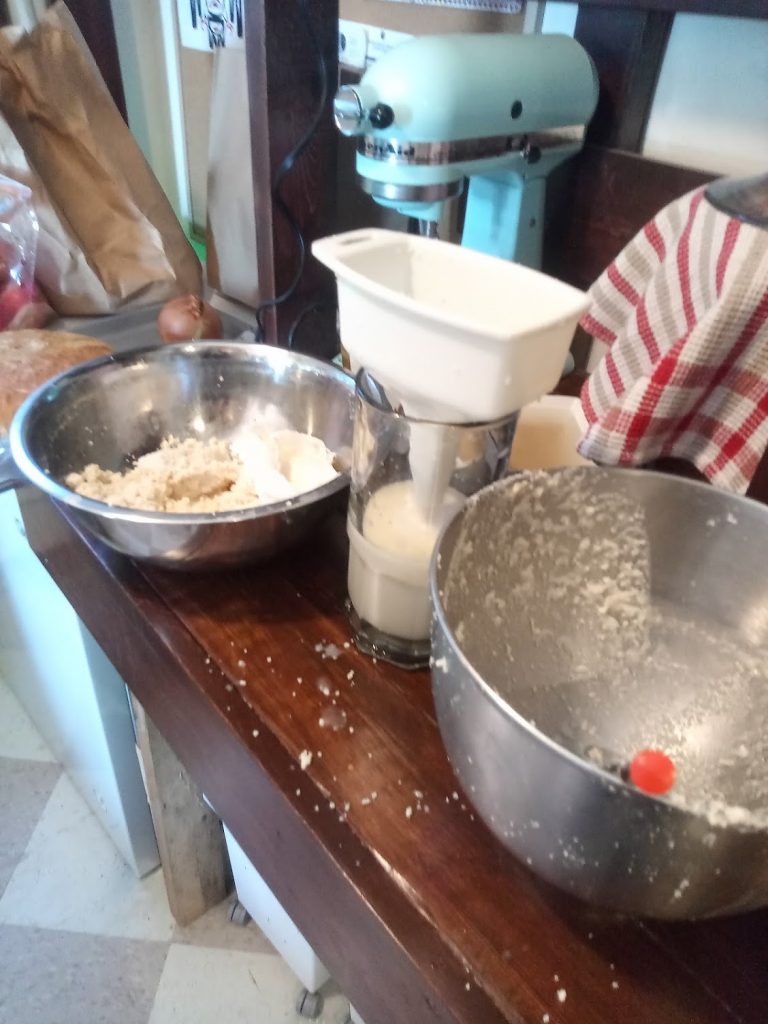
The scene of the crime
On top of that, the grinding of the almonds was very time-consuming and hard on the arm and hand. Because of this, we decided to use a food processor to speed up the process, but we were once again humbled when we had to strain the liquid from the almonds with a cheesecloth. So messy!!
Barley Water
| Flavor without lemon juice Nick = 8/10 Anjuli = 7/10 Audrey = 4/10 Flavor with lemon juice Nick = 8/10 Anjuli = 8/10 Audrey = 7/10 | Texture We chose to drink the water hot. | Scent Nick = 4/10 Anjuli = 6/10 Audrey = 3/10 |
We were all very surprised at how sweet the Barley water was! Audrey compared the taste with pasta water with a LOT of sugar (disgusting!), but Anjuli and Nick liked the flavour (hot nutty and sweet water) and could see why people drank the mixture as a tea. The recipe we followed recommended adding lemon juice for an extra kick, and wow, what a change! It tasted like lemonade (Audrey was instantly hooked), and it would have been refreshing in the summer.
As for the scent, the barley was stronger than the sugar, and Audrey was instantly reminded of the smell of dirty but wet dishes in a sink. The sugar added an extra layer of disgusting, but the lemon juice once again saved the day and subtly overpowered the other smells.
Poudre Douce
| Flavor Nick = 8/10 Anjuli = 7/10 Audrey = 10/10 | Texture The spices were well crushed and were homogenous with the sugar. | Scent Nick = 9/10 Anjuli = 9/10 Audrey = 10/10 |
While it was only a small component of the overall meal, we were very excited to try the Poudre Douce as it included spices that none of us had ever tasted before and ones that we would never have thought of putting in a savoury dish. The recipe we used is far from the only one, but we believe it turned out quite tasty, despite the subpar quality of our spice grinding. Medieval chefs definitively had far stronger forearms than we do!
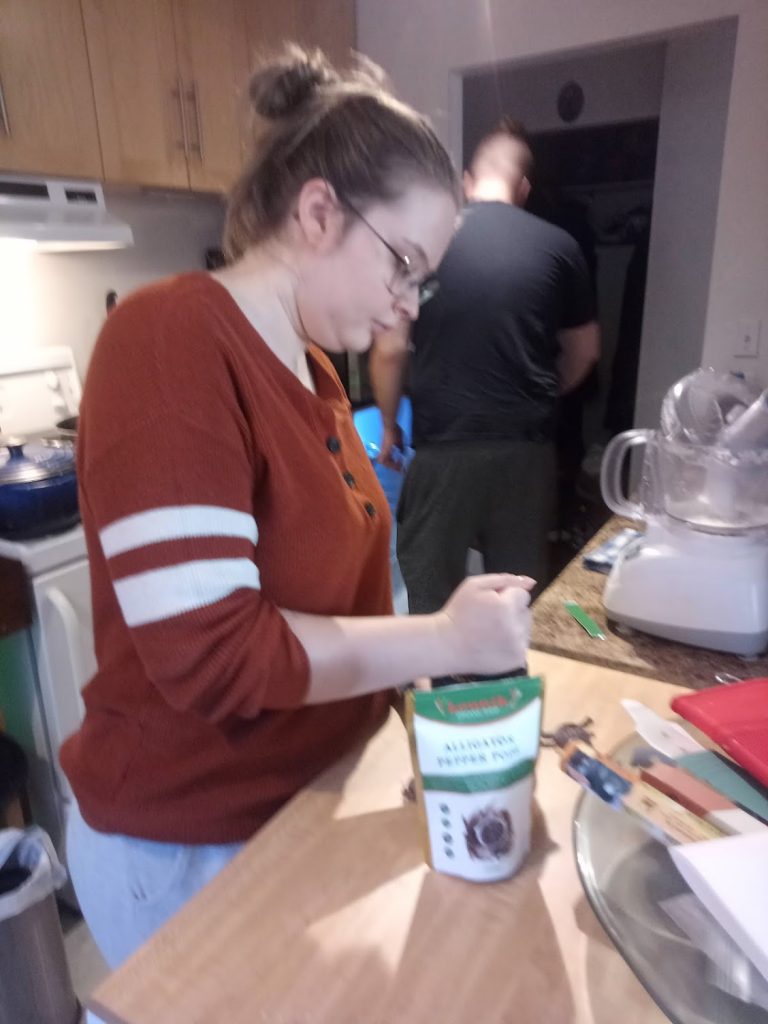
Anjuli’s workout of the day!
As you can see by our ratings, the Poudre douce was a hit! The spices smelled so nice and added a unique flavour profile to the turnips. The grains of paradise also had an interesting citrusy note, and the galingale was sweet/spicy but not as strong as the ginger. In our opinion, this mix could be used in other recipes like cookies, meats, other veggies… really anything, it was so good!
Rye Bread
| Flavor Nick = 7/10 Anjuli = 6/10 Audrey = 6/10 | Texture Nick = 7/10 Anjuli = 7/10 Audrey = 7/10 | Scent Nick = 7/10 Nick was the only one that got to smell the hot bread right out of the oven. Once it was cold, it had no distinct scent. |
Unfortunately, the bread featured in a previous blog turned out better than our final attempt — Nick thinks that it’s because the second dough was not wet enough. Despite being very dense, the bread was perfect for absorbing all the flavours of the Cinnamon Brewet!
We couldn’t identify any differences between this recipe and modern ones. Bread is bread – there’s not much to it! But we did notice that we were stuffed after one or two pieces, so we can see how the rye bread would have been perfect for a long day at work or to fill empty stomachs in times of scarcity.
Our Additional Thoughts:
The Poudre douce was also the only recipe we used that had written quantities for the ingredients. Most measurements were not standardized at this time because people did not have measuring equipment found in our modern kitchens. On top of this lack of standardization, recipes were often written in a manner that could be interpreted for both a single family and an entire banquet (Taillevent & Scully, 1988). Thus, the inclusion of quantities in all our recipes would have been unusual in the medieval period.
Vegetable recipes were not considered noteworthy in the medieval period, so they were not usually included in cookbooks. The turnip dish we made did not have a name, and the recipe focuses mainly on instructing how to harvest and prepare the vegetable itself rather than how to cook it. The recipe was included alongside instructions on salting ham or identifying good cheese, rather than with the other recipes (Greco & Rose, 2009).
While extremely underwhelming, the recipe for apple muse was interesting in its inclusion of multiple ingredients for food colouring. Many recipes of the time include saffron for food colouring, but this recipe also includes sandalwood to achieve its red colour. Unlike modern food colouring, these ingredients added taste to the food alongside colouring. For example, sandalwood powder is bitter and is rarely used in modern recipes due to its flavour. Including these ingredients stressed to us how vital the dish’s appearance was, maybe even taking priority over taste.
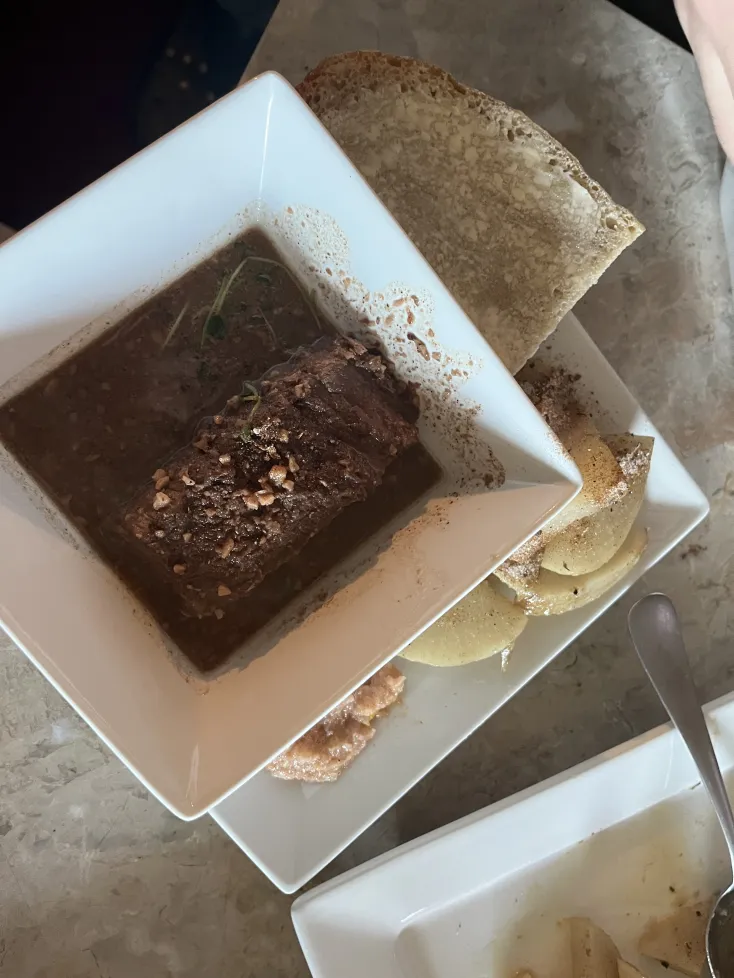
Yum yum yum
For our secound research question: How does it feel to finally sit down and taste our creations together?
After 3 hours of cooking, we were tired, hungry, and excited to finally taste our dishes! The order of courses were very different in medieval times than they are now. Unlike today, dessert/sweet dishes would not have been consumed separately from the savoury dishes (Greco & Rose, 2009). To imitate this, we served all of our dishes at the same time and ate them all together. But because the meal was so rich in protein, we were stuffed after a few bites! Eating made us sleepy and we were so thankful for Nick’s dishwasher — all the recipes asked for a lot of bowls, utensils, and pots.
References
Greco, G. L., & Rose, C. M. (2009). The Good Wife’s Guide (Le Ménagier de Paris): A Medieval Household Book. Cornell University Press.
Taillevent, & Scully, T. (Ed). (1988). The Viandier of Taillevent: An Edition of all Extant Manuscripts. University of Ottawa Press.
Our cooking day!
We all met at Nick’s apartment on the 24th of November at 11 am to start our medieval meal. Nick had made bread and beef stock the night prior, and thankfully so, as they were both time-consuming and labour-intensive. Since meat dishes usually take the longest, we started with the cinnamon brewet. We quartered the meat as instructed, then sautéed (seared) it in a hot cast iron pot, and added the wine and beef stock to deglaze.
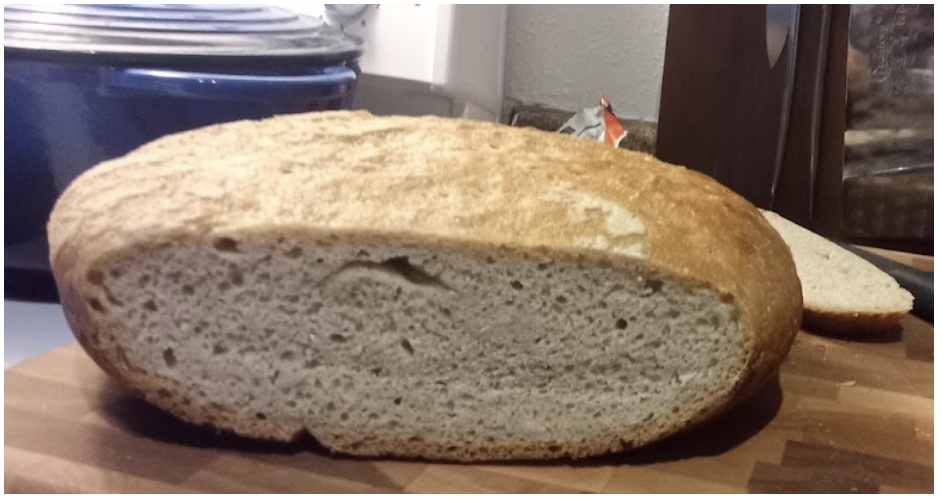
The Bread
In the meantime, we ground the almonds with a food processor, but we were then stumped by the following instructions. The recipe told us to: “grind unpeeled, dry almonds, and a great deal of cinnamon, moisten them with beef broth and strain them, boil them well with your meat.” Confused, we decided to ignore the section of the recipe telling us to strain the almonds. We then added to our pot all the other spices (ginger, cloves, cinnamon, and grains of paradise) and the red wine vinegar, which was our substitute for verjuice (unripe grape juice). This was left to simmer for three hours, and we added a bit more liquid to the brewet once or twice.
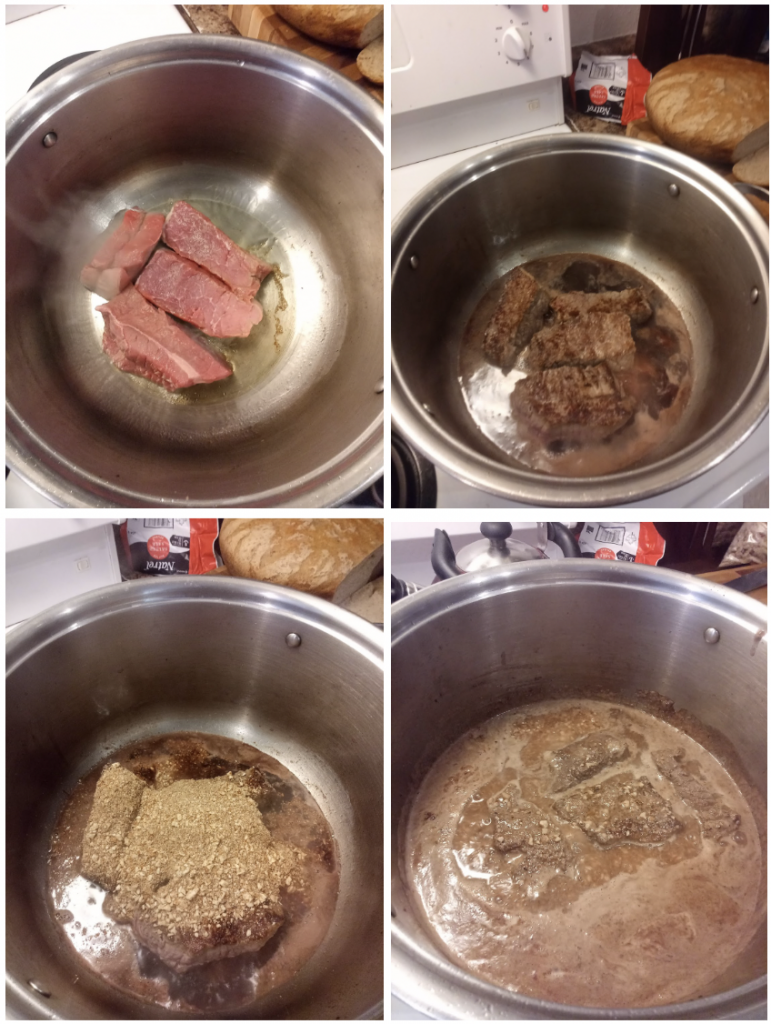
The Cinnamon Brewet
Anjuli started mixing spices to make the poudre douce. Since the galangal was extremely dry and impossible to crush, we improvised and decided to soak a few pieces in hot water. Once they had absorbed some of the water (enough to ease processing), we finely diced up the galangal and crushed it as best we could. When it resembled a rough paste, we put it in the oven for about fifteen minutes. When we removed it from the oven, it was completely dry and ready to be scraped into the mortar with all the other ingredients: ginger, sugar, cinnamon, nutmeg, and grains of paradise.
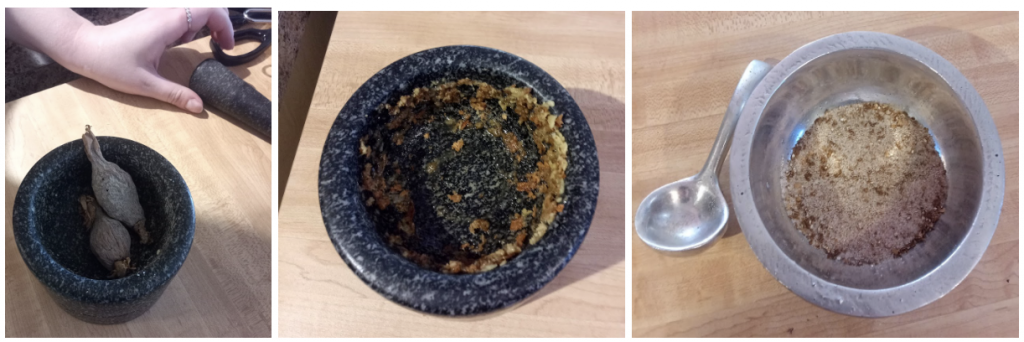
The Alligator Pepper Pods, the Galangal, and the resulting Poudre Douce
We boiled water for the almond milk (ground almonds) and barley water (barley and sugar). After waiting fifteen minutes, we strained the almond milk through a cheesecloth and funnelled it into a large glass. The process was messy but yielded a nice, thick almond milk for the fridge. The barley, sugar, and hot water mixture was then placed to boil over the stove until the barley burst. After straining it, we chose to serve the barley water hot.
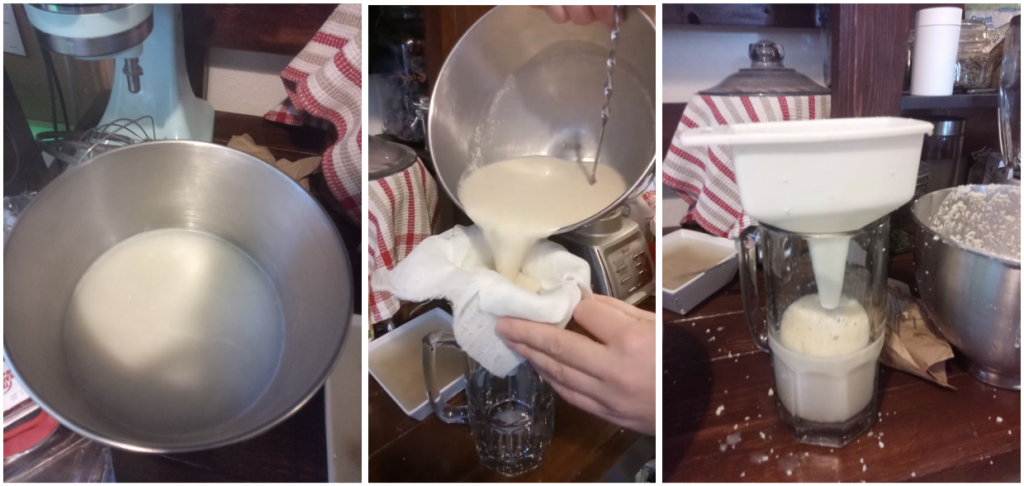
The Almond Milk
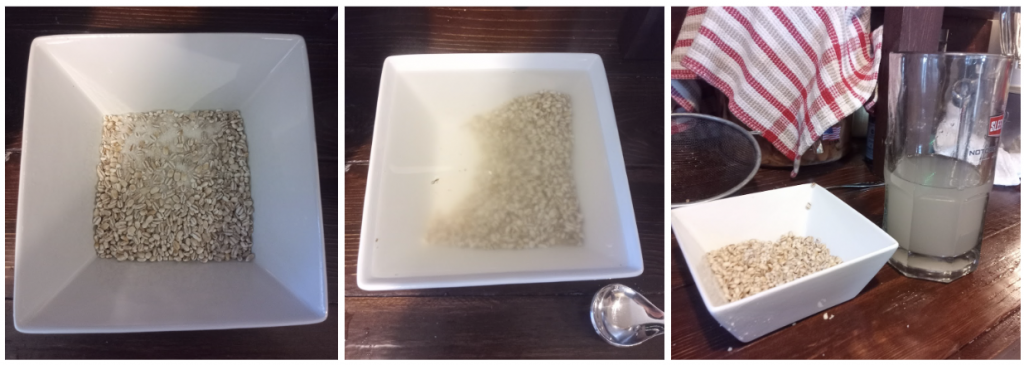
The Barley Water
Now that we had the almond milk, we started our apple muse. We peeled, cored and diced two apples and simmered them in water. Once the apples had softened, we crushed them and added the honey, sandalwood powder, saffron, salt, almond milk, and breadcrumbs made from the bread that we made the previous week. All of this together made a reddish, thick apple paste.
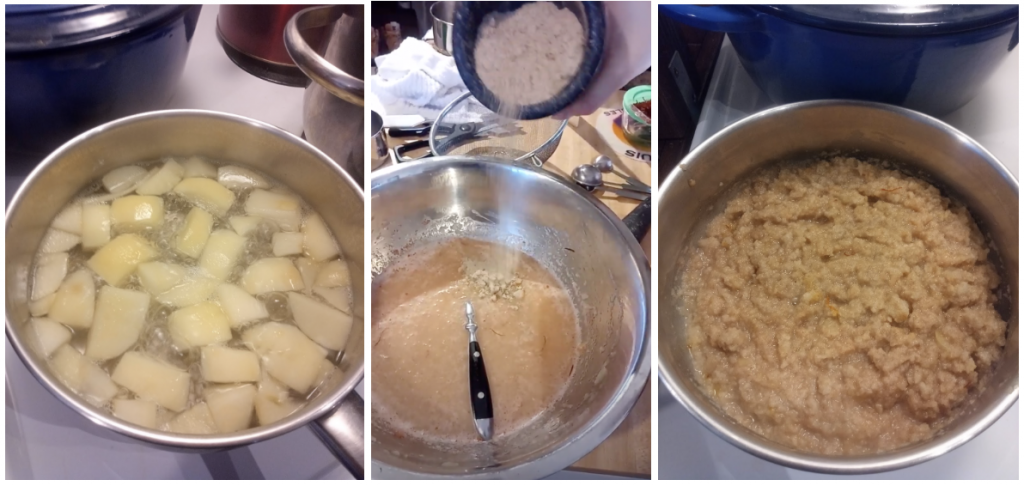
The Apple Muse
We prepared another pot with beef stock and halved turnips to simmer until soft. We then cut the turnips into quarter-inch slices to fry in a hot cast iron skillet with butter and seasoned generously with poudre douce.

The Turnips
By this point we were all hungry and ready to dig in, so we plated each dish and gathered around the table to dish ourselves up. After hours of cooking, we were excited to taste the fruits of our labour. Our ratings and reflections on each dish will be posted in a later blog.
Our meal may not have been entirely authentic due to the ambiguity in the written recipes and the use of modern cooking implements. That being said, we did get a good idea of what kind of flavour profiles were present in Late Medieval France.
Our Recipe Sources part 3
Two Fifteenth-Century Cookery-Books
As the name suggests, this book is a compilation of two medieval manuscripts that are found in the British Museum. It also contains extracts from three other texts. The two main manuscripts are named Harlien MS. 279 (written around 1430) and Harlien MS. 4016 (written around 1450). Altogether, this text contains around 500 recipes. The full name is “Two fifteenth-century cookery-books: Harleian MS. 279 (ab 1430), & Harl. MS. 4016 (ab. 1450), with extracts from Ashmole MS. 1439, Laud MS. 553, & Douce MS. 55;” it was compiled by the Oxford University Press and published in 1888.
We will only use one recipe from this text; the apple muse. The intext recipe is as follows:
Apple Muse: Take Appelys an sethe hem, an Serge*. [ Sift. ] hem þorwe a Sefe in-to a potte; þanne take Almaunde Mylke & Hony, an caste þer-to, an gratid Brede, Safroun, Saunderys, & Salt a lytil, & caste all in þe potte & lete hem sethe; & loke þat þou stere it wyl, & serue it forth. (Austin, 1888).
-Notes for this recipe: Saunderys refers to sandalwood.
Reference
Austin, T. (Ed.). (1888). Two fifteenth-Century Cookery-Books: Harleian MS. 279 (ab 1430), & Harl. MS. 4016 (ab. 1450), with extracts from Ashmole MS. 1439, Laud MS. 553, & Douce MS. 55. Oxford University Press.
Our Recipe Sources part 2
Le Ménagier de Paris
This book was not written as a cookbook, although it does contain many recipes. It was written as a sort of guidebook to running a household. There are several surviving complete manuscripts of this text, which was written in the late 1300’s. The book is written in the voice of an aging wealthy husband to his young bride; the author is anonymous. This massive book contains advice on such topics as how to behave, how to dress, how to choose and care for servants and horses, and how to cook. The book contains more than 380 recipes, although several are not culinary recipes. There are also recipes for things like pest control poisons and invisible ink.
The English translation we will be using is named “The Good Wife’s Guide (Le Ménagier de Paris): A Medieval Household Book,” and was published in 2009. We are using three recipes from this book. The recipes we will be using are for poudre douce (sweet powder), a turnip dish, sweet tisane (barley water), and almond milk. The written recipes are as follows:
Poudre Douce: Hippocras. To make hippocras powder, pound together a quartern of very fine cinnamon, selected by tasting it, half a quartern of choice cassia buds, an ounce of hand-picked, fine white Mecca ginger, an ounce of grains of paradise, and a sixth of an ounce of nutmeg and galingale together. And nota that the powder and the sugar mixed together make “duke’s powder.” (Greco & Rose, 2009).
-Notes for this recipe: we will only make the Hippocras powder, not the Hippocras itself (a spiced wine). As this recipe notes, the powder, when mixed with sugar, makes “duke’s powder” (poudre douce).
Turnip Dish (unnamed): Turnips are firm and difficult to cook until they have been through the cold and frost. Cut off the head and tail and other whiskery rootlets or roots. After peeling them, wash in two or three changes of good, hot water; then cook them in steaming meat stock of either pork, beef, or mutton. Item, in Beauce after cooking them, they slice them up and fry them in a pan and sprinkle them with spices. (Greco & Rose, 2009).
-Notes for this recipe: we will be sprinkling poudre douce on the turnips after frying them in butter. They would likely have used a solid animal fat such as butter or lard in France rather than something like olive oil, which would have been more widely used further south.
Barley Water: Sweet tisane. Boil water, then for each septier of water add one generous bowl of barley—it doesn’t matter if it is all hulled—and two parisis’ worth of licorice; item, also figs. Boil until the barley bursts, then strain through two or three pieces of linen. Put plenty of rock sugar in each goblet. The barley that remains can be fed to poultry to fatten them. Nota that the youngest licorice is the best; when cut it is bright green, while the older is more faded and dead and dry. (Greco & Rose, 2009).
Almond Milk: Hazelnut beverage. Boil and peel the nuts, mix in cold water, then grind them and thin with boiled water and strain. Do this, grind and strain, twice. Then put in the cellar to cool; it is quite a bit better than a tisane. 302. Beverage of almond milk as above. (Greco & Rose, 2009)
-Notes for this recipe: we will substitute almonds for hazelnuts to create almond milk, as specified later in the recipe.
The premise of this book is very interesting; it is not written as a guide to the elite as other contemporary cookbooks are, and it is very detailed. The amount of work that goes into a manuscript, an illuminated one at that, is monumental. Manuscripts were very expensive in terms of time, money, and effort to produce. This book draws on content from Le Viandier, implying that the author was familiar with that work and borrowed from it in their own writings.
The sheer quantity of topics covered in this work, in my opinion, gives the reader a near-unprecedented look at life in middle-upper-class medieval France. There are so many hidden gems within this text for readers to discover.
Reference
Greco, G. L., & Rose, C. M. (2009). The Good Wife’s Guide (Le Ménagier de Paris): A Medieval Household Book. Cornell University Press.
Our Recipe Sources Part 1
Le Viandier
The recipes found in this book come from a compilation of four partial manuscripts; there is no one (surviving) complete book that makes up Le Viandier. Each manuscript contains variations, and each one contains errors. This book is accredited to Guillaume Tirel, a cook for various members of the French royal family, and was presumably first written in the 1300’s.
The version we have been using is an English translation named “The Viandier of Taillevent: An Edition of all Extant Manuscripts,” which was published in 1988. The only recipe we will draw from this text is one for ‘Brouet de Canelle’ (Cinnamon Brewet). The in-text recipe is as follows:
Cinnamon Brewet: Cook your poultry in wine or in water, or cook any other meat, quarter it and sautee it; then grind unpeeled, dry almonds and a great deal of cinnamon, moisten them with beef broth and strain them, and boil them well with your meat, along with verjuice; and add ground ginger, cloves and grains of paradise. It should be thick and strong. (Taillevent & Scully, 1988)
-Notes for this recipe: We will use a beef roast as our meat.
While we have chosen to use only one recipe from this text, there is a great wealth of information to be found within its pages, and it is certainly worth reading.
Reference
Taillevent, & Scully, T. (Ed). (1988). The Viandier of Taillevent: An Edition of all Extant Manuscripts. University of Ottawa Press.
First Bread Run
November 10th
So, I have been growing a sourdough starter for the bread aspect of our project as the recipe calls for one and a half cups of starter to leaven the bread (see “our ingredients” section). Since it has been mostly cool in my apartment these last few weeks the starter has been developing slower and is not quite ready to use for bread yet. Instead, I substituted two and a quarter teaspoons of dry active yeast and about half a cup of water.
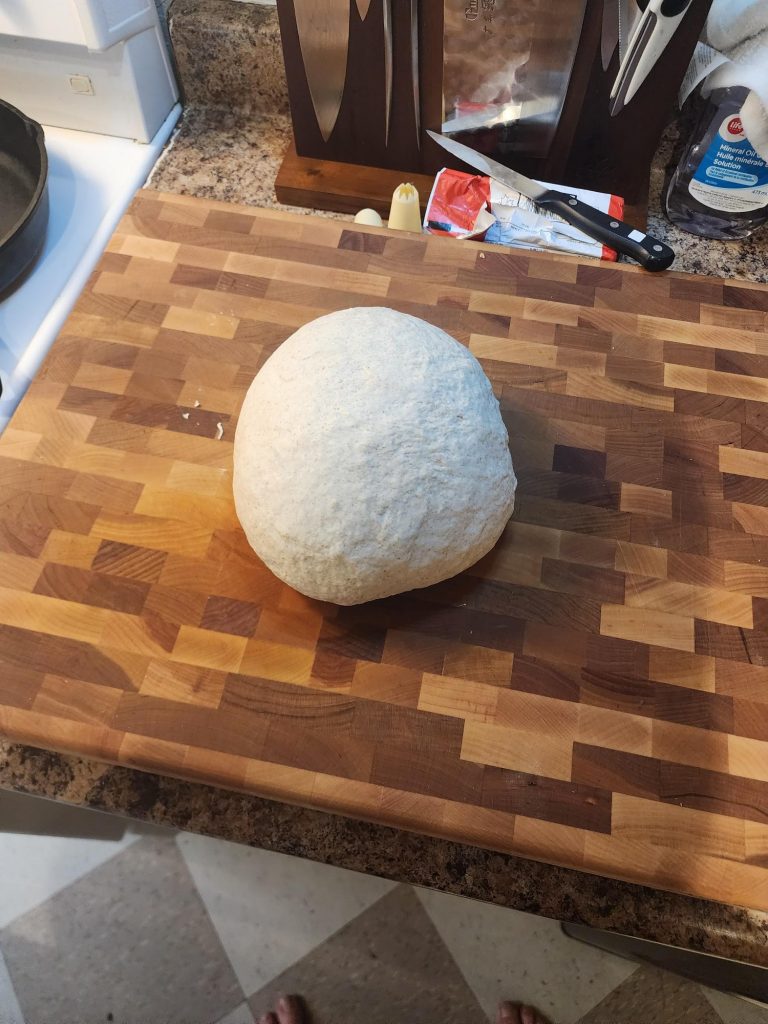
I kneaded the dough for about fifteen minutes, rolled it in a ball and placed in my Dutch oven. I poured about a teaspoon of olive oil on top of the ball, place the lid and let proof for about an hour. Then, punched and folded the dough and let rise for another half hour while I preheated the oven to 320 degrees Fahrenheit.
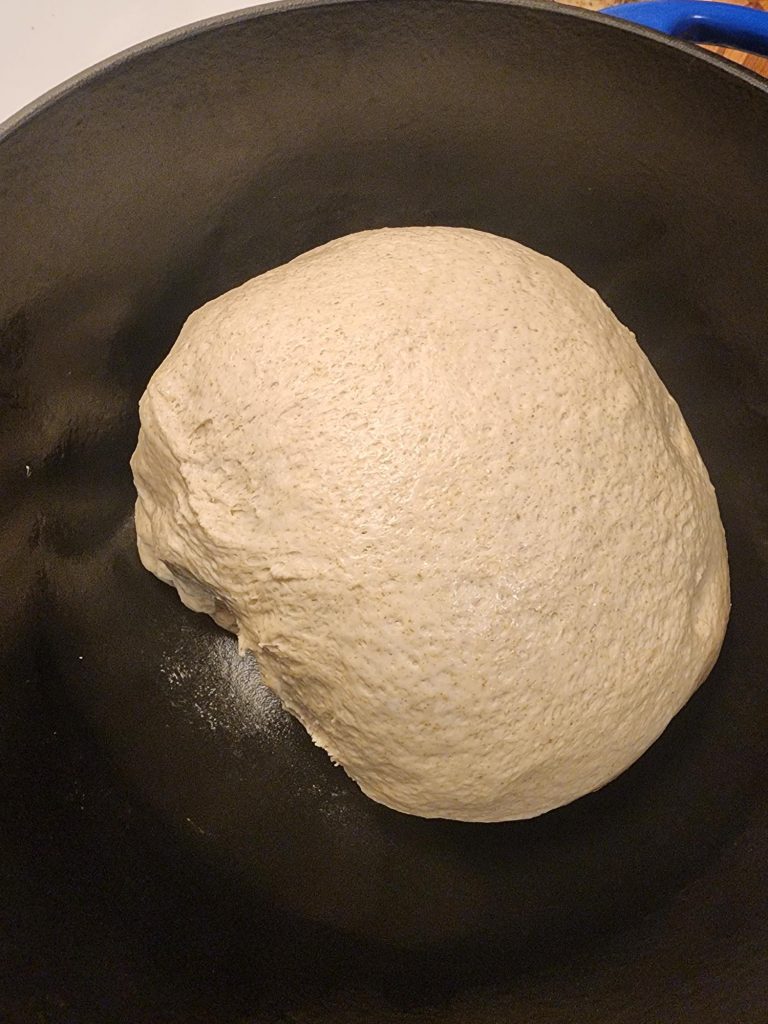
I baked the bread for 40 minutes in the lidded Dutch oven then removed it from the oven and turned it up to 400 degrees Fahrenheit. I took the lid off, sprinkled the bread with a bit of cool water and put it back in the oven for about 25 minutes. I scooped it out of the pot and placed it on a rack to cool. It’s almost a shame that I will be cutting it up and drying it to make breadcrumbs for one of our recipes, as it is one of the better breads I have made.

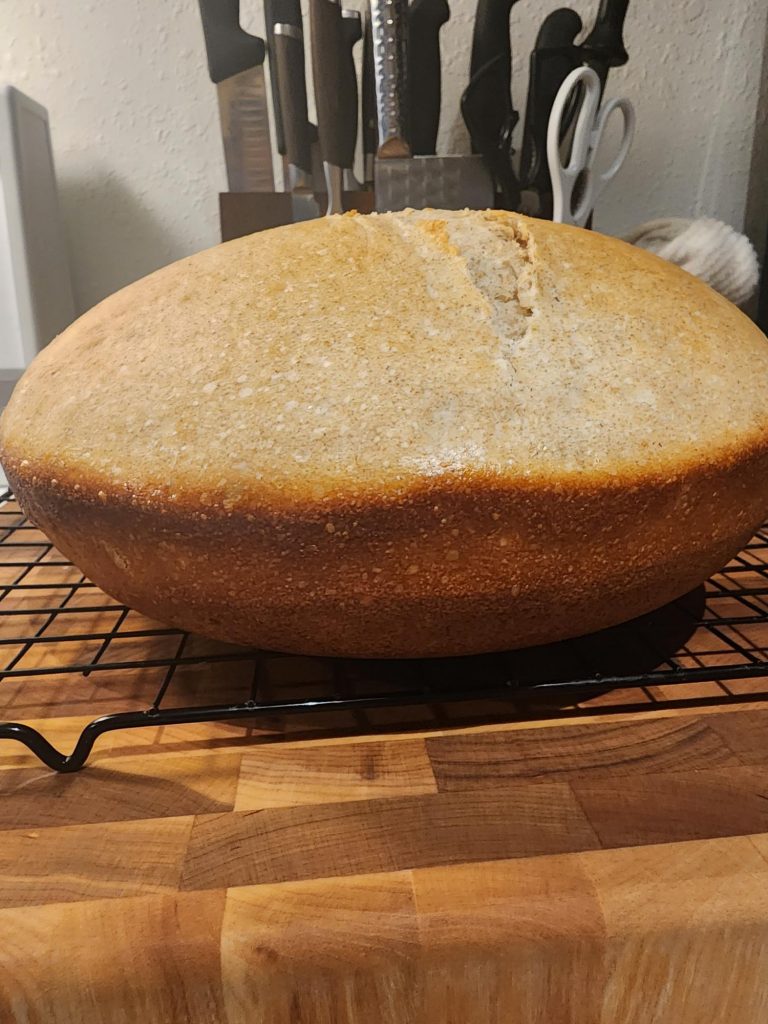
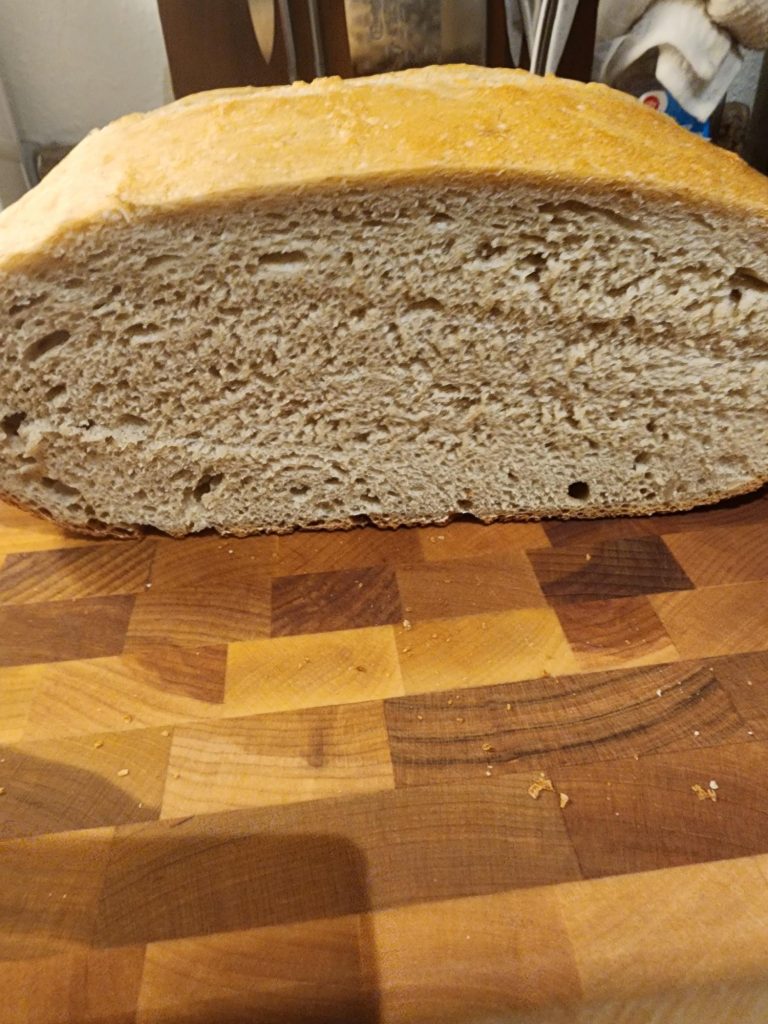
I will be starting a second sourdough starter this weekend to ensure that we have a starter that is ready for our cooking day on November 24th. To make the starter I use rye flower, distilled water (the chlorine in tap water will kill the bacteria) a teaspoon of unpasteurized honey to give the starter a little head start as well as flavour. Mix in a glass jar, and cover with a cloth in a warm and dark place. The consistency should be like mud, and about half an inch thick. Double the size of the mixture everyday for five days, then on the fifth day empty three quarters of it and start the process again with the remainder. At day 10 – 12 the starter should be doubling in size after every feeding. Then the starter should be ready to use.
Once the starter is ready it can be refrigerated and fed once a week or kept on the counter and fed everyday. To feed, all that is needed is doubling the mixture already present with fresh flour and water. I will post the details of use when making bread with the starter once it has taken.
A Highlight on Medieval Spices
Spices served many functions in the Middle Ages; they were not simply there to make food taste good. Along with taste, spices were used in remedies and recipes to balance one’s humours and to demonstrate one’s wealth (the ability to buy great quantities of such luxurious goods). They were not used to disguise the scent of rotting meat; someone who could afford spices could afford to eat unspoiled meat. Spices were imported from far-off and exotic lands, having to travel great distances to reach North-Western Europe.
Despite their luxurious nature, by the later Middle Ages, the middle and upper classes had become accustomed to eating spiced foods. By the 15th century, the availability of spices increased, and while volatile, prices decreased (Belich, 2022). These factors meant that there was greater accessibility of spices to a greater number of people.
Some of the spices commonly consumed in the Late Middle Ages would have been very familiar to us; others are less recognizable. Here’s a list and some brief descriptions of some of the spices we will be using in our project; hopefully, a few of these spices will be new to you!
Cloves were used as a flavouring as well as a food preservative in Medieval times. This spice is strong and pungent; it is still commonly used in cooking today (“Clove,” 2023). In terms of humoural theory, cloves are defined as hot and dry (Amar & Lev, 2016).
Image from Michlitch Spokane Spice
https://www.spokanespice.com/itemdetail.php?id=540&secid=60
This spice is from the ginger family but has a sweet/spicy taste that cannot be substituted with ginger. This spice is now commonly referred to as galangal and is still used today in Southeast Asian cuisine. In terms of humoral theory, galingale is hot and dry (Amar & Lev, 2016)

Image from Simply Recipes
https://www.simplyrecipes.com/what-is-galangal-5209585
Grains of Paradise was a common flavouring agent used in Medieval cooking; this spice is also from the ginger family but tastes like a citrusy black pepper. This spice is also called melegueta pepper; this spice has mostly fallen out of popularity and is hard to come by (Freedman, 2008). In terms of humoural theory, grains of paradise are hot and moist (“Grains of Paradise,” 2023).
Image from Ekaterra
https://ekaterra.com/products/alligator-pepper
This spice was mainly used in the Middle Ages to give colour to food rather than to add any sort of taste. It comes from the stigma of a certain flower; it is still used but is hand-cultivated and very expensive (“Saffron,” 2023).
Image from Sativus.com
https://www.sativus.com/en/saffron/
Sandalwood was used in the Middle Ages as a food colouring rather than a flavouring; the taste of this wood is bitter. Sandalwood is no longer commonly used in cooking, as it tastes bitter, and some variations are poisonous. Humourally, sandalwood is dry (Jharwal, 2023). Medieval food recreators occasionally leave sandalwood out of recipes because of the modern abundance of food colourings that do not taste bitter, but we have chosen to leave it in because the bitterness added will be authentic to the original recipe.
Image from Ebay
https://www.ebay.ca/itm/165980361645
References
Amar, Z., & Lev, E. (2016). Arabian Drugs in Medieval Mediterranean Medicine. Edinburgh University Press. https://doi.org/10.1515/9780748697823
Belich, J. (2022). 4 Expansive Trades. In The World the Plague Made: The Black Death and the Rise of Europe (pp. 106-122). Princeton: Princeton University Press. https://doi-org.ezproxy.library.uvic.ca/10.1515/9780691222875-009
Britannica, T. Editors of Encyclopaedia (2023, October 19). Clove. Encyclopedia Britannica. https://www.britannica.com/plant/clove
Britannica, T. Editors of Encyclopaedia (2023, October 9). Saffron. Encyclopedia Britannica. https://www.britannica.com/topic/saffron
Das, G., Patra, J. K., Gonçalves, S., Romano, A., Gutiérrez-Grijalva, E. P., Heredia, J. B., Talukdar, A. D., Shome, S., & Shin, H.-S. (2020). Galangal, the multipotent super spices: A comprehensive review. Trends in Food Science & Technology, 101, 50–62. https://doi.org/10.1016/j.tifs.2020.04.032
Freedman, P. H. (2008). The Medieval Taste for Spices. Historically Speaking, 9(7), 2–5. https://doi.org/10.1353/hsp.2008.0024
Jharwal, A. (2023, September). Red sandalwood (Pterocarpus santalinus): Benefits & uses for skin. Medium. https://medium.com/@arunjharwal/red-sandalwood-pterocarpus-santalinus-benefits-uses-for-skin-9adec44092f9 Wikimedia Foundation. (2023, October). Grains of Paradise. Wikipedia. https://en.wikipedia.org/wiki/Grains_of_paradise#cite_note-7
Wikimedia Foundation. (2023, October). Grains of Paradise. Wikipedia. https://en.wikipedia.org/wiki/Grains_of_paradise#cite_note-7
